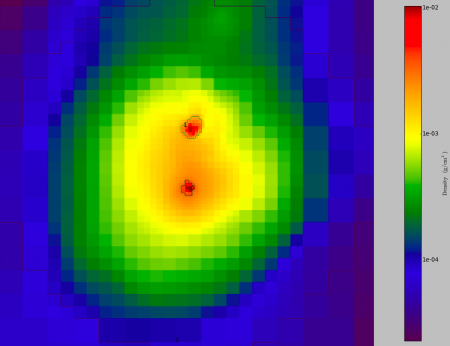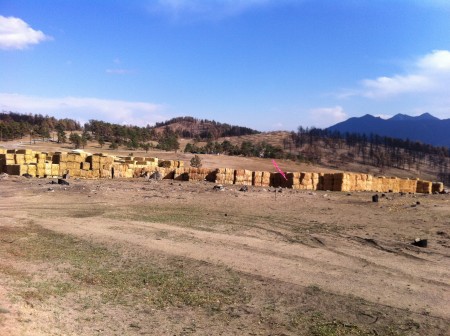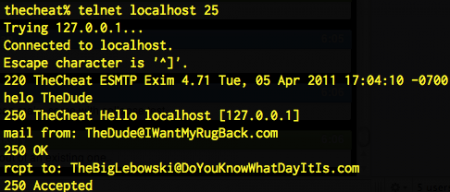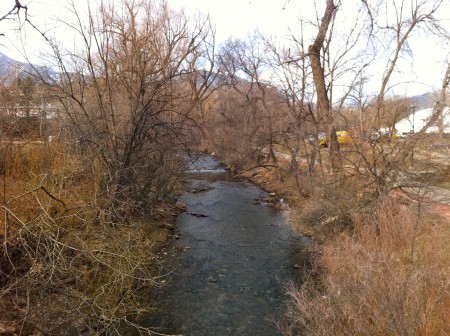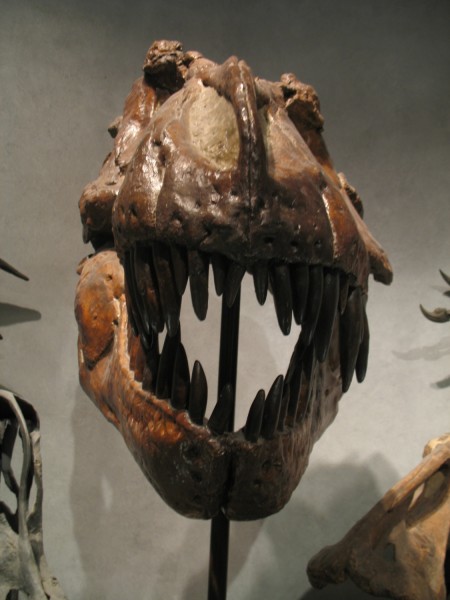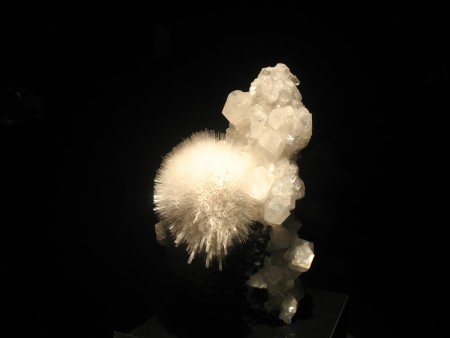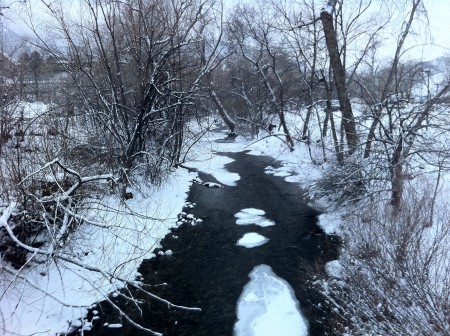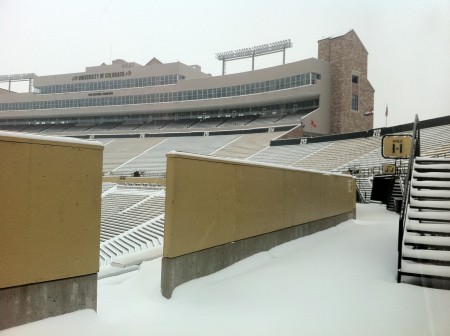Steve Winwood – Arc of a Diver
Springtime in Boulder is a tumultuous time. Most evenings the clouds get blown down off the mountains and it rains, and a few times it's turned into snow overnight. The days are blustery and mild, but not what I would call warm just quite yet. The album Arc of a Diver by Steve Winwood does not fit well into my seasonal or geographical mood. If I were in Florida sipping a fruity drink on the beach, I think it would be more appropriate. It would help if I was older and fatter, too. I'm trying to say that if you are in the right place and frame of mind, this album could be quite pleasant. And sometimes pleasant is all you need.
I'm going to try to catch up completely this week.
more ...Blob Identification
I have access to some of the fastest computers in the world. I can summon thousands of processors, petabytes of disk storage, and terabytes of memory with a few keystrokes. You'd think with that kind of power, analysis could be automated and done in massive pipelines. But that's not always true. Sometimes things are so subtle that the most efficient method is still to use the human eye.
Today I was pretty ill, with a sore throat and congestion. It was the kind of day for lying on the couch and watching movies. Luckily, I was able to accomplish some work that didn't require too much concentration. First, some context.
One of my current projects is looking at the centers of simulated galaxy clusters, and it is actually surprisingly difficult to find the centers of the clusters. Clusters are complicated places, with clumps of matter falling in, sloshing stuff around, making the core not exactly clear. In order to semi-automate the process, I wrote a script that makes pictures of the clusters (which have been previously identified in a automated fashion), that have density contours superimposed. The density contours are analogous to the lines on a topographical map.
The picture above is an example of the output of the script. The colors indicate gas density, blue to red is low to high. If you look at the full-sized image, you can see that there are two dense clumps numbered 0 and 1. I can't just pick the most dense cluster because that might be a tiny blob of matter falling into the larger cluster; more care is needed. So I need to make the decision with my adaptable brain. The script spits out the image, and then I have to input which clump I think is the most central clump, and a record is made which I'll use for the next step in my chain of analysis. I spent most of today looking at these pictures and entering numbers. Yay for tax payers!
This is very similar to the Galaxy Zoo project that aimed to identify the morphology of actual galaxies, but my effort is on a much smaller and simpler scale.
So - which clump do you think is the most central above?
more ...Rush – Moving Pictures
Luckily for me, I will not draw the ire of any Canadians with this review. In fact, I already had the album Moving Pictures by Rush before this review because I like it. The songs are well made, a couple are catchy, and it's not too long. Go ahead and check out the album yourself!
more ...Journey – Captured
I wasn't looking forward to Captured by Journey. I've already listened to two albums like this (1, 2) and I was thinking that this album would bore me. I have to admit that I wasn't bored completely by this album, which surprised me. This album is a live album, made up of recordings from several different performances. I think that the energy of the live performances makes the music less soporific, which is good.
If I have one complaint, it's that this album is a bit too long in duration. By the last few songs I was getting kind of tired of Journey. But it took until the end of the album to get there, so that's a small amount of praise. Nonetheless, this is an album you can skip.
more ...Kool & The Gang - Celebrate!
I am way late on this review. Many weeks. In my defense, I did some traveling, and the gap that was only going to be 3 weeks just grew and grew. So in the interest of getting back on time, I'm going to do some quick, short reviews until I'm back in sync.
The album Celebrate! by Kool & the Gang has exactly one song you will ever hear: the title track "Celebration". And that's all you need to know. The rest of it is not very exciting.
I will remark that the second song on the album is about divorce. Either it's intentionally ironic to follow a song like Celebration with a song about divorce, or fantastically incongruous.
more ...A Gold Star
A gold star to the first person who can figure out what's happening in this photo (click to enlarge). This was taken just an hour ago on my bike ride on Sunshine Canyon Dr. above Boulder. I think everything you need to know is in the photo. Good luck!
more ...Making the Switch
Looking at the oldest email I can find, I have been using my Yahoo email address for nearly 9 years. Back then, there was no Gmail as an option. The only other webmail that was comparable was Hotmail. And there was no way I was going to use Hotmail because it was, and still is, owned by Microsoft. For much of that time I have even paid a yearly fee to Yahoo to remove advertisements and add other features.
In the last year I have become increasingly unhappy about Yahoo mail. They have refused to enable IMAP for anything but smart phones. GMail has enabled IMAP for everything for a long time. Yahoo's servers are slow and flaky. Sometimes I cannot access my mail for half an hour (or more) until someone (presumably) does something somewhere to clear it up. I could overlook all of these things, mainly because I knew that switching email providers would be a chore.
However, the last straw was when they added a new feature that allows you to chat with your facebook friends in Yahoo mail. I suppose that this might be useful to some people, but it smacks of "me too" by Yahoo. The faceplace is the new hotness, something Yahoo hasn't been in a decade, and since Yahoo can't innovate their way back into relevance, they've just given up. This is the kind of stuff that insults my sensibilities.
Initially unrelated to all of this, my brother recently purchased a new domain: skory.us. He purchased it primarily so he could make a 10 digit email address: ?@skory.us (? = some letter of the alphabet). I thought that was pretty cool, and I wanted in on that action.
What pushed me to make a decision is that in a couple weeks my Yahoo mail membership comes due, and I didn't want to give them any more money.
Therefore, last weekend I decided to sign up for a free Google Apps account using the skory.us domain. I swapped the MX DNS records over to Google's servers, and started pulling all my old email from my Yahoo account. The pull of 50,000+ emails took over a week and wasn't straightforward. I had to baby sit it daily on each end. THIS is why I was so hesitant to switch email providers because I knew it would be a hassle, and it was a hassle.
The move wasn't perfect - although I pulled all my sent mail (i.e. email I wrote), I can't get it into the Google sent mail folder. And there's still more work to do. I have my Yahoo address in many, many places on the internet that I am going to have to slowly change. In the meantime, the Yahoo email will forward to Google.
Finally, here's my new email address in a human parse-able but obfuscated format. Update your address books!
Betasso Preserve
Taken yesterday on the Betasso Link Trail to the Betasso Preserve above Boulder at about 2000m/6600ft. The CU Campus is visible in the gap at the bottom of the canyon. The horizontal color gradient is due to different exposures & white balances for the individual pictures that make up the panorama. I could probably fix it, but it's OK. As always, click above to enbiggen. Here's the GPS track of the ride.
more ...NCAR Panorama
Click the image for the full 2.6MB version. It's a bit grainy because it's from my cell phone. Taken approximately here, today. It snowed yesterday, but it warmed up quickly enough for a bike ride today.
p.s. NCAR = The National Center for Atmospheric Research. Science, supercomputers, grand views, and award-winning architecture: what's not to like about that? I wouldn't mind working there.
more ...'The Denver Museum of Nature & Science'
Yesterday Melissa and I went to the Denver Museum of Nature & Science. Like many big-city science museums, it is targeted towards the ankle-biter set, but it is still fun for fuddy-duddy adults like us. If there is a theme for the museum, it's Colorado and Western history, which is dominated by mining and resource extraction. There is a very large and impressive collection of gems, many of which originated in Colorado. I didn't take as many photos as I should have, and it was difficult to take good photos in the dim light, but below is an example of how amazing some of them are. For some reason, they have a very large topaz gemstone that was previously owned by Salvador Dali.
There is also a space sciences exhibit with plenty of hands-on displays for children to interact with. The one I liked best is a meteoroid simulator that is Rube Goldberg-esque. Enclosed is a sand pit with a pressurized nozzle above that shoots ball bearings downward into the sand. The bearings make a crater in the sand that is similar to what a meteoroid does to a planet. When all the bearings have been shot, an automated rake sweeps the sand, dumping them into a sluice that feeds a chain lift, closing the cycle. It's debatable how much some of the children were learning from it, but it is fun.
On the West side of the museum is a very nice atrium with an excellent view of downtown Denver and the front range. I'm sure that the foreground looks better in the summer when the grass is green, but in the winter the snow-capped peaks make up for that. If you look carefully in the full-sized panorama, you can see the gold dome of the State Capitol, and a flock of some ubiquitous Canada Geese.
more ...Styx – Paradise Theater
The album Paradise Theater by the band Styx does not include their song ["Mr. Roboto"][4]. For most of you, that is your signal to stop caring about this review and move on with your day. The brave, the steadfast, and the bored may continue on!
This album is not terribly dissimilar from last week's album, which is somewhat disappointing. I was not thrilled with REO Speedwagon, and this album isn't any different for me, if I'm honest. The most I can say about this album is about one song, which is the only one that made an impression on my brain. The song "She Cares" has the line: "she treats me like a human", which is such a vacuous (*) statement that it needs to be commented on. How else might "she" treat the singer of the song? Like a dog? A teacup? A 1953 Studebaker Commander Starliner? I can understand the need to rhyme in a rock song, but that line is insulting to either "she" or the singer, and definitely to the listener's intelligence.
My recommendation for this album is identical to last week's album: skip it, and if you must, just listen to bad radio and Styx will come on eventually. "Mr. Roboto" is kind of fun, so if they play that, consider yourself lucky. Note that the content of the top-10 albums list does not change for three weeks, which is how long it will be until my next review.
(*) I wanted to pick a good synonym for "stupid" to describe the line in the song, so I went to the Mac OS X system Dictionary application which includes a thesaurus. The entry on "stupid" synonyms has a bonus section apparently unique to this word titled "Choose The Right Word" that advises which synonym is appropriate for each situation, and how to avoid insulting someone unnecessarily. I think the next iteration of IBM's Watson should include the ability to scan an email for misuse of "stupid" synonyms. Think of all the marriages and friendships that might be preserved!
more ...REO Speedwagon – Hi Infidelity
Named for a precursor of the pickup truck (the O stands for Olds, who also founded Oldsmobile), REO Speedwagon reached the zenith of their popularity in 1981 with the album Hi Infidelity.
If you do not know what REO Speedwagon sounds like, think of the band "Journey", and that will be close enough most of the time. One exception is the song "In Your Letter", which sounds like 1950's bubble-gum rock, and even includes backup female doo-wop singers. I have to admit that for one of the hits on the album, "Take It On The Run", I had previously only heard covers of the song. I think I like the covers better.
The main problem I have with this album is that it is the kind of music I hear played incessantly on the worst FM radio stations across the country. These are mostly owned by Clear Channel, including Jack FM, which I loathe. REO Speedwagon isn't awful music, it's just bland, and it gets played by radio stations that purport to have wide variety, but don't.
Therefore, my suggestion is to not listen to this album. If you need your dose of this music, there is almost certainly a Jack FM in your town, and REO Speedwagon will be played eventually.
more ...